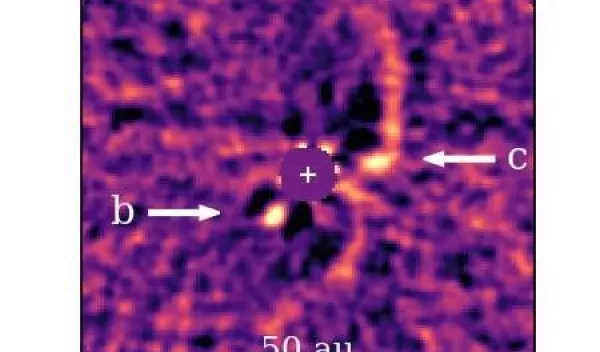
Astronomers confirm existence of two giant, newborn planets in PDS 70 system
New evidence confirms that first-ever pictures do capture the birth of a pair of planets orbiting the star PDS 70.
Using a new infrared pyramid wavefront sensor for adaptive optics correction at the W. M. Keck Observatory on Mauna Kea in Hawaii, a Caltech team of astronomers applied a new method of taking photos of the baby planets, or protoplanets, and confirmed their existence. The National Science Foundation supported the work through a Major Research Instrumentation award to significantly upgrade the adaptive optics system on the 10-meter Keck II telescope.
The team's results are published in The Astronomical Journal.
PDS 70 is the first known multiplanetary system where astronomers can witness planet formation in action. The first direct image of one of its planets, PDS 70b, was taken in 2018, followed by multiple images taken at different wavelengths of its sibling, PDS 70c, in 2019. Both Jupiter-like protoplanets were discovered by the European Southern Observatory's Very Large Telescope.
"There was some confusion when the two protoplanets were first imaged," said Jason Wang, lead author of the study. "Planet embryos form from a disk of dust and gas surrounding a newborn star. This circumstellar material accretes onto the protoplanet, creating a kind of smokescreen that makes it difficult to differentiate the dusty, gaseous disk from the developing planet in an image."
To help provide clarity, the team developed a method to disentangle the image signals from the circumstellar disk and the protoplanets.
"We know the disk's shape should be a symmetrical ring around the star whereas a planet should be a single point in the image," said Wang. "So even if a planet appears to sit on top of the disk, which is the case with PDS 70c, based on our knowledge of how the disk looks throughout the whole image, we can infer how bright the disk should be at the location of the protoplanet and remove the disk signal. All that's left over is the planet's emission."
This project benefited from the innovative infrared sensor that measures distortions in light caused by the Earth’s atmosphere.
"New technology is a science multiplier," says Peter Kurczynski, a program director in NSF's Division of Astronomy. "It enables investigations that were never before possible."


